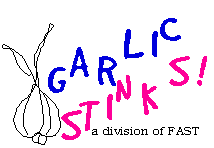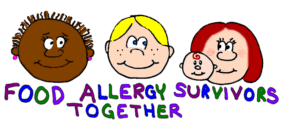|
|

Introduction
Although many people would think foods such as soy, milk, wheat, and eggs are hard to avoid, they generally have good substitutes, and health food and allergy foods cater to people with these allergies. Garlic, though, is in just about everything.
I have "met" many people who are allergic to garlic and agree that it is almost impossible to avoid. Therefore I saw a need for this section of FAST. Many people may not yet know that garlic is present in so many items, and may be reacting to an unknown allergen when ingesting foods. It's not as commonly tested with food allergy tests, either. So it is my hope that this page will help those who not only know about their garlic allergy, but also may suspect one.
One time we purchased a whole case of a new canned tomato soup which did not list garlic as an ingredient (in fact, I don't even believe it said "spices," though I could be wrong). Suspicions arose in my mind when I noticed the border all around the label was graphics of garlic cloves! A call to the company revealed that garlic was present. They were very suspicious of us and at first did not want to give out the information, thinking we were a rival company. They said that by law they do not need to list garlic as an ingredient, and if they did that other companies would copy their product! Unfortunately, FDA labeling laws are currently such that they allow companies to have labels such as these.
In early 1998, I started reacting every evening to something I was ingesting either at lunch or dinner (since it takes me, typically, a few hours to react if I only ingest a minute amount of an allergen). The reaction was mild diarrhea accompanied with a painful stomach-ache. Sure enough, the ketchup I was using nearly every evening had unlabeled garlic! One ketchup company said people with allergies to garlic would honestly be much better off making their own, because people like us would never find a ketchup without garlic -- labeled or otherwise.
Current labeling laws let them label garlic oil as a "spice." Note: Companies are required to list garlic; but not garlic in all of its forms. Many, many companies use "garlic oil" and simply list it collectively with "spices." Companies may not even know that garlic is in their product, since they purchase different components/flavorings from different companies.
What Can I Do?
In order to make your situation known, you cannot just sit idly by and hope that someone else does something about it.
Call or write to companies (it can be more helpful to ask for responses in writing; include a SASE) and make sure that their products are garlic-free. I recommend not trying any spicy product or product that says "spices" or "natural flavorings/flavors" until you have called and have been 100% assured that garlic (aside from your other allergens, as well) is not present.
Garlic-Free Recipes
Our family loves spicy foods, and this can cause some problems since garlic is in almost all store-bought spicy foods. However, garlic is NOT NEEDED to make a food spicy. Peppers, if you are not allergic to them, are a GREAT substitute, taste better, and don't give you stinky old garlic breath! The salsa recipe on this page can be used as a dip for chips, and can also be used as flavoring (for example, we puree it and put it in refried beans for use in tacos and as nachos). Bon apetite!
Ketchup
(Why in the world would you need a recipe for ketchup? Store-bought ketchups often contain wheat, corn, garlic, and other spices within their flavorings! By making your own, you can control what ingredients are in the ketchup. If you're allergic to some of the spices mentioned below, experiment with the recipe and use ones that you can have instead.)
Melissa Taylor (with thanks to Suzanne Lichtenstein for a couple of ingredient tips.)
6 oz. can of tomato paste (Contadina brand is recommended by Suzanne)
1 tablespoon apple-cider vinegar
1/4 teaspoon salt
1 1/2 teaspoon hot sauce (purchase one made with apple-cider vinegar rather than "normal" vinegar, which can contain wheat, and call on any other questionable ingredients before using)
1/4 teaspoon onion powder
1 tablespoon molasses
3 tablespoons water
Dash pepper
Dash celery salt
Add all ingredients to a bowl; stir until fully combined. Add to a ketchup container for "normalcy" if desired (you can purchase a squeeze bottle), and store in the fridge.
Use on French Fries, burgers, and any recipes that call for ketchup!
Note (added April 30, 2002): Ketchup fans! I recently got the book The Original White House Cook Book 1887 Edition (this is a reprint and is under $20), and it includes three ketchup recipes (p. 156) that are garlic-free. These are the old-fashioned kind of recipes where you use fresh tomatoes. One of the recipes is for green ketchup! Also includes ketchup recipes using walnuts, oysters, mushrooms, gooseberries, cucumbers, currants, apples, and celery. This is the first cookbook I have seen which contains ketchups that actually sound good.
No Garlic, No Mess, No Time, (almost) No Cooking Pizza
by Wendy Shaw (Note: Wendy has given permission for this recipe to be reproduced in other resources; no need to write and ask for permission.)
Ingredients (no need to measure):
Flour tortillas (any size)
Tomato Paste (Check label. A few brands contain "spices")
Italian herbs (sold in spice section already combined)
Shredded "Pizza Cheese" (Several companies put out a preshredded mix)
Salt & pepper
Place tortillas on a foil lined baking sheet, and spread with tomato paste
(yep, just spread it straight from the can like spreading peanut butter!).
Over this, shake a liberal amount of mixed italian herbs (or mix your own
herbs), and salt and pepper to taste.
Cover with a layer of shredded pizza cheese (or see variations below).
Bake at 400 degrees, about 5 minutes or until cheese is fully melted and
begins to bubble.
Cut in half or into wedges, cool slightly and serve.
Variations: Several companies sell a shredded mix of cheeses called "pizza
cheese," which gives an authentic pizza taste. But I actually prefer this
with shredded sharp cheddar instead. Grated parmesan may be shaken over the
pizza before or after baking. A layer of low-fat ricotta under the shredded
cheese is great, but a little messier for youngsters. In addition, any
topping that can go on "real" pizza can top these miniature versions. Because
they are "single serving sized," each child can top his/her own before baking.
Salsa
Melissa Taylor
1 cup water
4.5. ounce can green chili peppers
Dash salt (or desired)
1 teaspoon sugar
1 teaspoon lemon juice
3/4 cup tomato paste
1/4 cup jalapeno peppers*
Dash onion powder
1 tablespoon vinegar
1 teaspoon xanthan gum
* Use jalapeno peppers that come in a jar (pickled), and put 1/4 cup in a food processor with all the juice that is in the jar. Process until they are in the sized bits you want to use.
Combine all ingredients in a large bowl and stir to combine the ingredients. Store in the fridge.
Hot-Pickled Vegetables
Melissa Taylor
1 dash onion powder
1 cup water
1/2 to 1 teaspoon tabasco sauce
1 cup vinegar
1/2 teaspoon salt
Any other spices tolerated (not needed)
1/2 cup carrots
1/2 cup cucumber
1/2 cup jalapeno peppers
1/2 cup broccoflower
Put the two cups of vegetables on a boiler, covered in water (not water included in above ingredients listing). Let boil until the vegetables are all softened (some may be put in later if more soft).
After softened, drain off water and add remaining ingredients. Bring to a slight boil. Pour into a canning jar and seal. Let cool, and then refrigerate.
If you can't have onion powder and tabasco sauce, no worries. Just make sure to put in the jalapeno peppers and the recipe will still work.
Health Food Stores Probably Won't Help
A health food store is almost indespensable for families where food allergies are present. They offer a wide selection of food that contains alternative ingredients. For example, instead of wheat flour, their products may contain rice or barley flour. However, a health food store probably won't help when it comes to garlic allergies.
To the health food industry, garlic is a booming product. It is considered healthy, and garlic supplements are readily advertised on television and sold in stores.
When I first found out about my food allergies as a young teen, my parents tried to find out more about them. My mom booked me a meeting with a health food store owner out of town. We drove to her store only to be met by tips we already knew by reading, as well as some things we knew were not true. She continually pushed the garlic supplements she was selling, even though we told her about my allergy! She believed that the good outweighed the bad, although I would have ended up very, very sick if I had followed her advice.
I will leave you with one piece of advice. The best thing to do with a garlic allergy is to find something you used to like and look at its ingredient label. Reproduce it with store-bought individual items that you know to be garlic-free. For example, pickles can be home-made, as can salsa. Make a game of it, and have fun!
|


